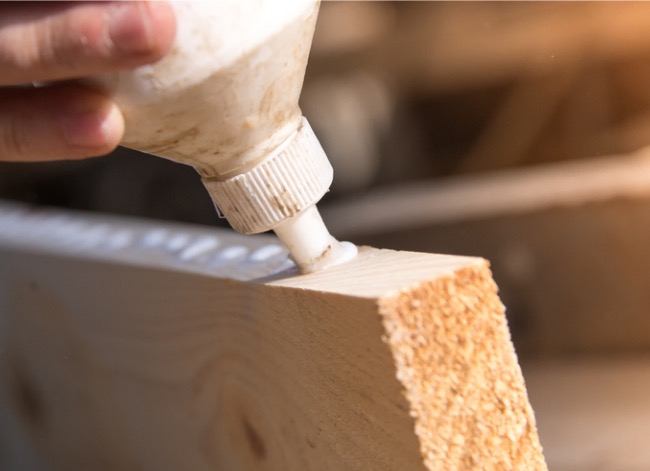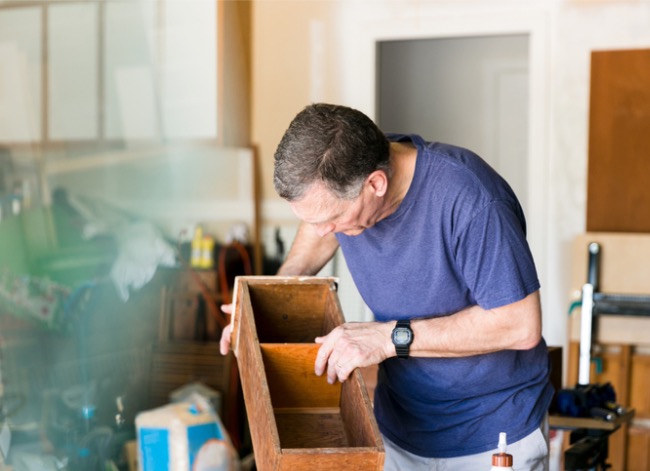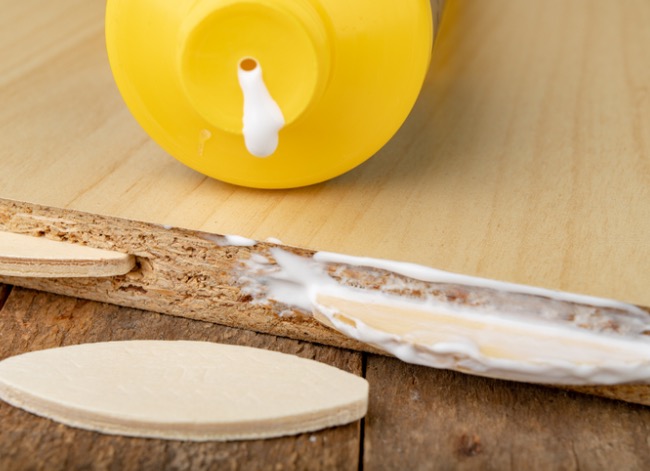

We may earn revenue from the products available on this page and participate in affiliate programs. Learn More ›
Q: I have some old wooden furniture that I’d like to restore. I was going to repair the damage with wood glue because it will look better than nails or screws. After I’ve fixed it, how long does it take wood glue to dry, so I can apply a finish and use it again?
A: Using wood glue is a great idea and glue can provide a strong, invisible repair that can last a lifetime. Wood glue is used for quick and easy fixes like when a small piece of laminate is split or lifted from the surface, or it can be used as a permanent bond when renovating wooden chairs, for example. Home woodworkers often use it for making new furniture.
However, it’s important to know how long a particular wood glue takes to dry. In most cases you’ll also need to clamp the joint while it’s drying. A length of paper tape could be adequate to keep a joint together while glue dries for minor repairs, though proper woodworking clamps will usually be needed for larger repairs. Clamps are readily available and needn’t be expensive.
Know the difference between drying and curing.
Manufacturers usually provide accurate guidance for drying times, so it’s always important to read the product label and follow instructions carefully for the best possible result. That said, the terms ‘drying’ and ‘curing’ can sometimes lead to confusion. So let’s clarify them.
Drying usually refers to the surface of the product being dry to the touch and the joint being secure enough for clamps to be removed (it’s sometimes referred to as clamping time). However, that doesn’t mean the bond is completely secure. Usually the chemical reaction is still going on. That period is the curing time. Only when this curing time has expired is it safe to apply a finish, or use the completed project.
RELATED: 7 Strong Types of Wood Joints Worth Knowing

Common types of wood glue and approximate dry times.
Here’s a quick look at commonly used wood glues and their likely drying times, though they can vary from one manufacturer to another:
- Polyvinyl acetate (PVA), often known simply as white glue, is an easy-to-use, general-purpose woodworking glue that can be clamped for as little as 30 minutes but takes around 24 hours to cure fully.
- Polyurethane wood glue helps fill small gaps and will glue a variety of different materials like stone, ceramics, and plastic as well as wood. Clamping time is around 2 hours with full cure taking 24 hours.
- Epoxy is a two-part product (resin and hardener) that is much thicker than PVA and polyurethane. Mostly used for small repairs, especially if they need to be drilled or screwed into, it also is used on boats because it is waterproof. Rapid-set epoxy cures in about 6 hours. The normal type takes 24 hours.
- Cyanoacrylate is better known as superglue and can dry enough to fix small repairs in seconds, though full cure might still take anywhere from 8 to 24 hours.
Air temperature, humidity, and the moisture content of the wood can all alter drying time.
PVA and polyurethane wood glue are the best choice in the vast majority of cases, but both are affected by air temperature. In general they won’t dry properly below 45 to 50 degrees Fahrenheit. In fact, PVA glue, which is water-based, can freeze. Manufacturers usually provide appropriate temperature information. Not following guidance can result in a joint that will eventually fail.
High humidity or wood that is not completely dry will extend the drying time of PVA glues. If this is an issue, increased ventilation will help. One method is to use a fan to blow cool air across the joint.
Polyurethane wood glue is actually water-activated. It needs some degree of moisture in order to activate. This makes it perfect for damp environments, or for lumber that isn’t fully dry. In dry atmospheres or with completely dry wood, it is necessary to apply a little moisture (using a fine spray or a damp cloth) before using polyurethane wood glue.
RELATED: The Best Glues for Plastic Models and DIY Projects

The type of wood you are gluing is also a factor.
Wood can broadly be divided into two types: softwood and hardwood. While this basically describes how tough they are, there are exceptions. Balsa, for example, is very light and easy to glue but is botanically a hardwood.
In general however, softwoods (like the pine boards at the lumberyard) grow quickly and have an open structure. This means they more readily absorb glue and bond more quickly. Often clamps can be removed sooner. Hardwoods grow more slowly and are much more dense as a result, so glue takes longer to penetrate and dry. Wood glues are equally effective on both types of wood, but it’s particularly important to allow full curing with hardwoods.
Applying too much glue can extend its dry time.
It’s tempting to apply lots of glue to a joint to ensure you have proper coverage and a strong bond. There are several good reasons for not doing this.
- First, you’ll extend the drying time. The surface will form a skin that gives the impression of being dry, but underneath the dry layer there is glue that’s still curing.
- Second, when using softwood and PVA wood glue you can ‘flood’ the structure. The wood absorbs too much glue which causes the fibers to swell. It can even start to push the joint apart, weakening it.
- Third, if you’re applying a finish to the wood—whether paint or varnish—the excess glue will have to be scraped and sanded off first. If the glue has soaked into the area around the joint, it can prevent the finish from adhering properly, changing its color so the job ends up looking patchy.
Always follow the manufacturer’s instructions but in general it is recommended to apply a thin coat to both surfaces to be joined. Any ‘squeeze out’ when the job is clamped should be wiped off straight away with a damp cloth.

RELATED: The Best Glues to Repair Your Most Treasured Ceramics, Tested
In most cases, you can be sure wood glue is dry after 24 hours.
The original question was how long does wood glue take to dry, and while different products, conditions, and types of wood all have an impact, we can be confident that 24 hours is pretty much always long enough.
There’s sometimes a tendency to be over-cautious and leave wood glue to dry for longer. That’s OK, but leaving clamps on too long should be avoided. Clamps create pressure. Leaving them on during the whole curing process can result in problems when that pressure is released and the wood returns to its normal shape. It’s best to tighten them carefully initially, applying the minimum pressure necessary to hold the joint closed. Then release them when the glue has had time to dry. They can be left in place if that’s more convenient, just backed off a turn or two.
Finally, it’s worth considering the stresses that the glued piece will experience. A piece of veneer that has lifted can have a dab of PVA glue applied and a piece of tape stuck over it to hold it in place for an hour or two. On the other hand, wood glue makers might recommend a longer cure period than normal for things like a chair, which will come under considerable pressure once back in use.
RELATED: How Long Does Caulk Take to Dry?
